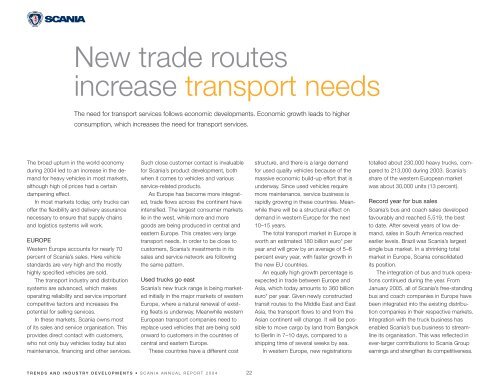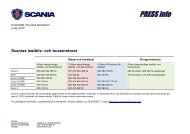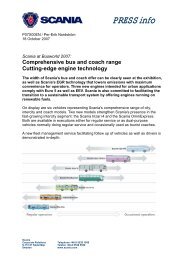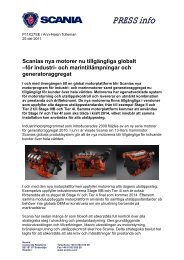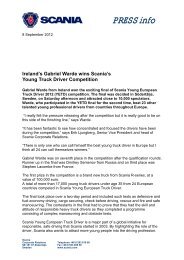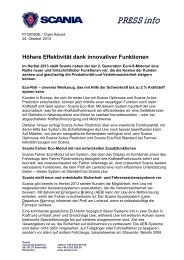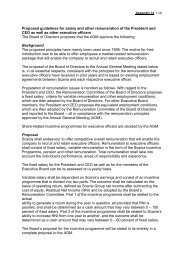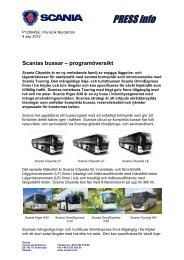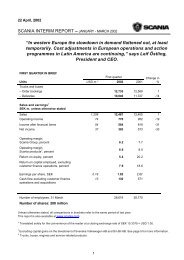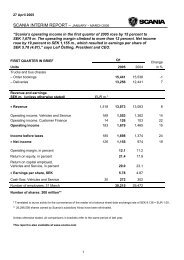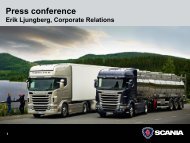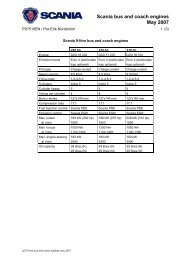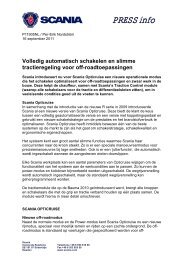Scania annual report 2004
Scania annual report 2004
Scania annual report 2004
Create successful ePaper yourself
Turn your PDF publications into a flip-book with our unique Google optimized e-Paper software.
New trade routes<br />
increase transport needs<br />
The need for transport services follows economic developments. Economic growth leads to higher<br />
consumption, which increases the need for transport services.<br />
The broad upturn in the world economy<br />
during <strong>2004</strong> led to an increase in the demand<br />
for heavy vehicles in most markets,<br />
although high oil prices had a certain<br />
dampening effect.<br />
In most markets today, only trucks can<br />
offer the flexibility and delivery assurance<br />
necessary to ensure that supply chains<br />
and logistics systems will work.<br />
EUROPE<br />
Western Europe accounts for nearly 70<br />
percent of <strong>Scania</strong>’s sales. Here vehicle<br />
standards are very high and the mostly<br />
highly specified vehicles are sold.<br />
The transport industry and distribution<br />
systems are advanced, which makes<br />
operating reliability and service important<br />
competitive factors and increases the<br />
potential for selling services.<br />
In these markets, <strong>Scania</strong> owns most<br />
of its sales and service organisation. This<br />
provides direct contact with customers,<br />
who not only buy vehicles today but also<br />
maintenance, financing and other services.<br />
Such close customer contact is invaluable<br />
for <strong>Scania</strong>’s product development, both<br />
when it comes to vehicles and various<br />
service-related products.<br />
As Europe has become more integrated,<br />
trade flows across the continent have<br />
intensified. The largest consumer markets<br />
lie in the west, while more and more<br />
goods are being produced in central and<br />
eastern Europe. This creates very large<br />
transport needs. In order to be close to<br />
customers, <strong>Scania</strong>’s investments in its<br />
sales and service network are following<br />
the same pattern.<br />
Used trucks go east<br />
<strong>Scania</strong>’s new truck range is being marketed<br />
initially in the major markets of western<br />
Europe, where a natural renewal of existing<br />
fleets is underway. Meanwhile western<br />
European transport companies need to<br />
replace used vehicles that are being sold<br />
onward to customers in the countries of<br />
central and eastern Europe.<br />
These countries have a different cost<br />
structure, and there is a large demand<br />
for used quality vehicles because of the<br />
massive economic build-up effort that is<br />
underway. Since used vehicles require<br />
more maintenance, service business is<br />
rapidly growing in these countries. Meanwhile<br />
there will be a structural effect on<br />
demand in western Europe for the next<br />
10–15 years.<br />
The total transport market in Europe is<br />
worth an estimated 180 billion euro* per<br />
year and will grow by an average of 5–6<br />
percent every year, with faster growth in<br />
the new EU countries.<br />
An equally high growth percentage is<br />
expected in trade between Europe and<br />
Asia, which today amounts to 360 billion<br />
euro* per year. Given newly constructed<br />
transit routes to the Middle East and East<br />
Asia, the transport flows to and from the<br />
Asian continent will change. It will be possible<br />
to move cargo by land from Bangkok<br />
to Berlin in 7–10 days, compared to a<br />
shipping time of several weeks by sea.<br />
In western Europe, new registrations<br />
totalled about 230,000 heavy trucks, compared<br />
to 213,000 during 2003. <strong>Scania</strong>’s<br />
share of the western European market<br />
was about 30,000 units (13 percent).<br />
Record year for bus sales<br />
<strong>Scania</strong>’s bus and coach sales developed<br />
favourably and reached 5,519, the best<br />
to date. After several years of low demand,<br />
sales in South America reached<br />
earlier levels. Brazil was <strong>Scania</strong>’s largest<br />
single bus market. In a shrinking total<br />
market in Europe, <strong>Scania</strong> consolidated<br />
its position.<br />
The integration of bus and truck operations<br />
continued during the year. From<br />
January 2005, all of <strong>Scania</strong>’s free-standing<br />
bus and coach companies in Europe have<br />
been integrated into the existing distribution<br />
companies in their respective markets.<br />
Integration with the truck business has<br />
enabled <strong>Scania</strong>’s bus business to streamline<br />
its organisation. This was reflected in<br />
ever-larger contributions to <strong>Scania</strong> Group<br />
earnings and strengthen its competitiveness.<br />
TRENDS AND INDUSTRY DEVELOPMENTS • SCANIA ANNUAL REPORT <strong>2004</strong> 22


